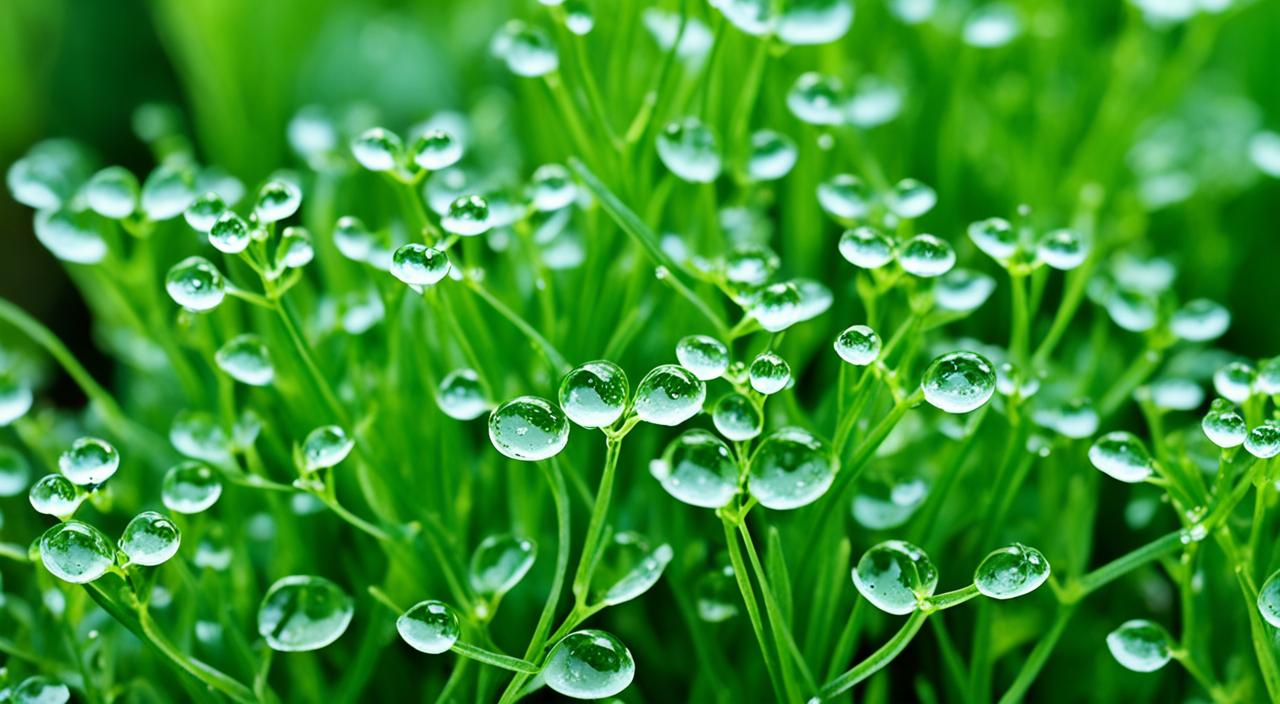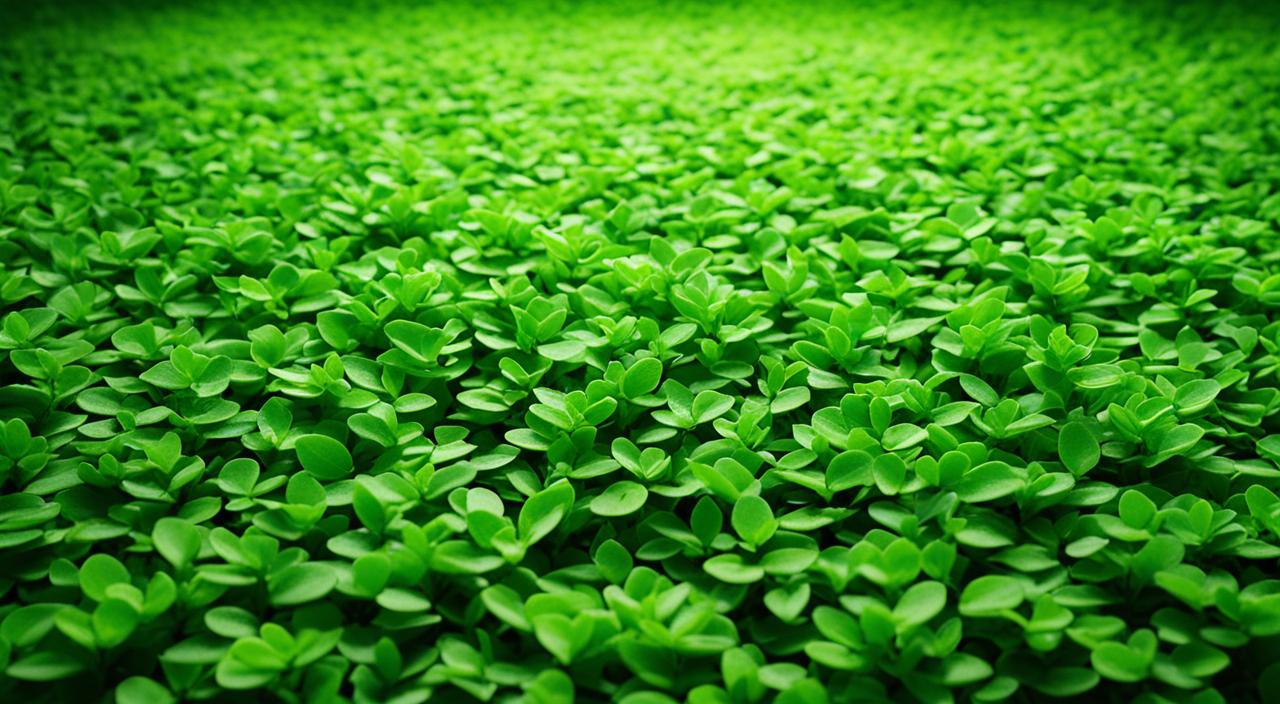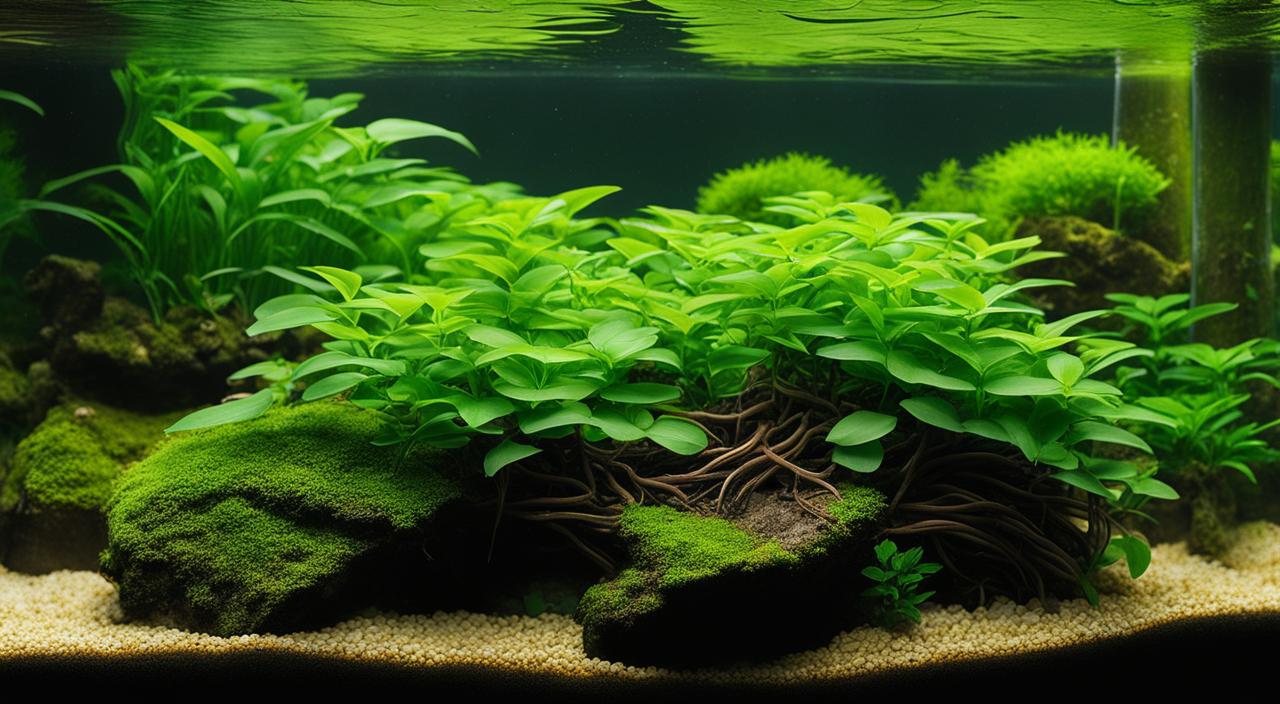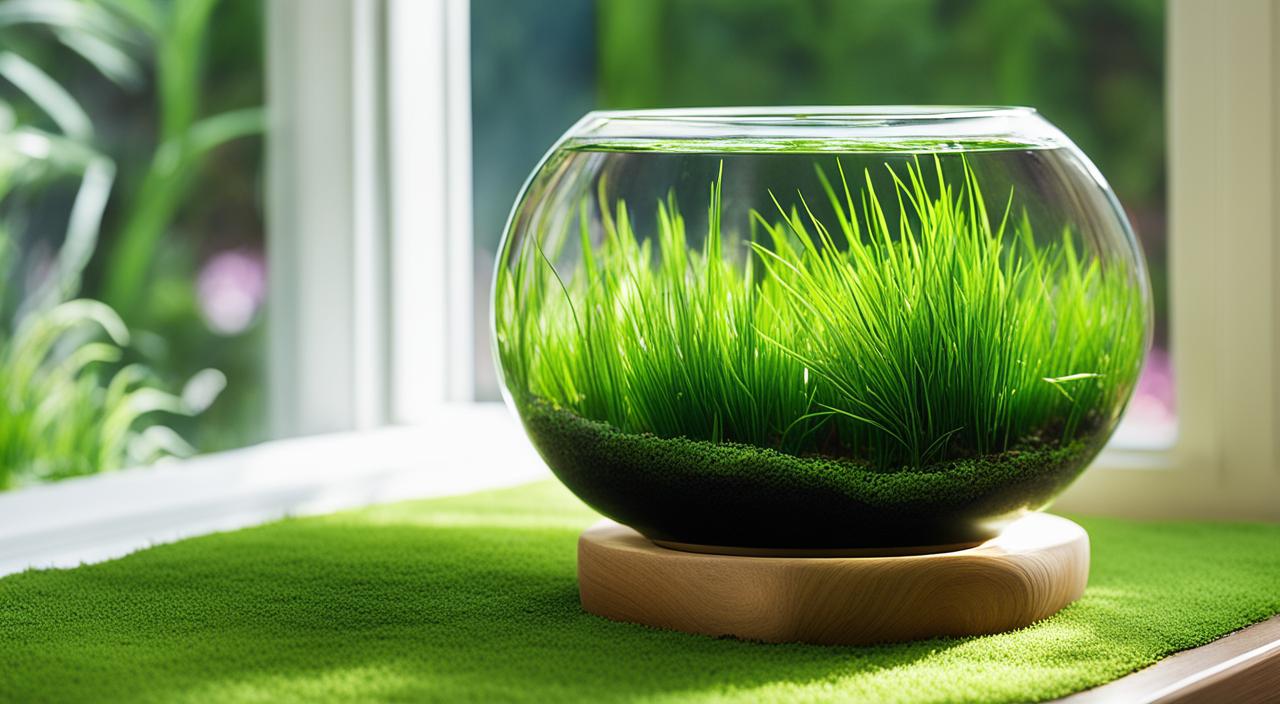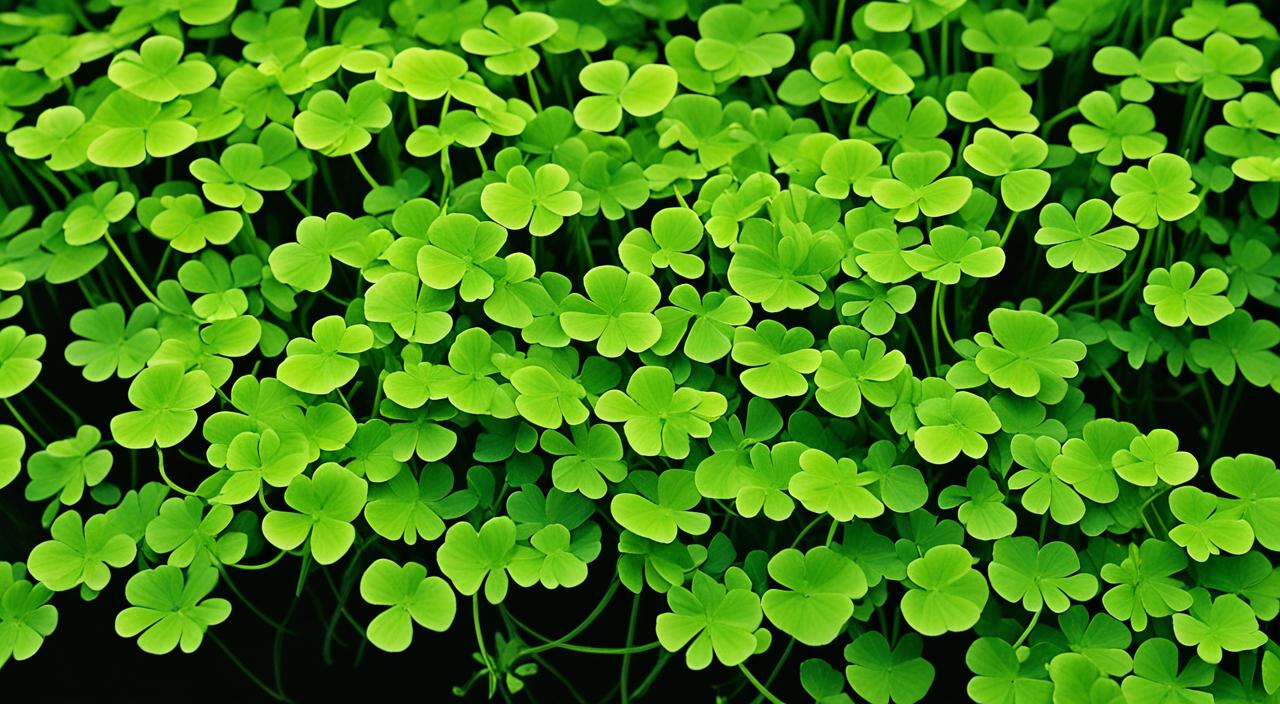As an aquarium enthusiast, I am always looking for unique and captivating plants to enhance the beauty of my aquatic setups. One plant that has caught my attention is Dwarf Baby Tears (Hemianthus callitrichoides), a stunning green carpet plant that can transform any aquarium into a vibrant underwater landscape. In this article, I will delve into the world of Dwarf Baby Tears, exploring its care requirements and its ability to create a lush and visually appealing carpet in high-light aquatic environments.
Key Takeaways:
- Dwarf Baby Tears (Hemianthus callitrichoides) is famous for aquarium carpet plants.
- It requires high light and CO2 injection to thrive, making it a demanding aquarium plant.
- Native to North America and Cuba, Dwarf Baby Tears forms dense mats in its natural habitat.
- Proper placement and lighting are crucial for successfully cultivating Dwarf Baby Tears.
- Dwarf Baby Tears can coexist with various fish and invertebrates as tank mates.
Brief Overview Of Dwarf Baby Tears (Hemianthus callitrichoides)
Dwarf Baby Tears, also known as Hemianthus callitrichoides or HC, is a popular choice for aquascaping enthusiasts. It is a small plant with bright green leaves forming a dense aquarium carpet.
This plant requires high light and CO2 injection to grow, making it a favourite among aquarists looking to create a lush and vibrant aquascape.
Dwarf Baby Tears can be planted in the substrate or attached to a hardscape element such as rocks or driftwood. It is a versatile plant that can be used in various styles of freshwater aquascapes.
Origins And Habitat
Dwarf Baby Tears is native to North America and Cuba. It grows in shallow, slow-moving waters like streams, rivers, and marshes. This plant prefers areas with high light intensity and rich nutrient levels. In its natural habitat, Dwarf Baby Tears forms dense mats that provide shelter and food for tiny aquatic organisms. It is adapted to grow submerged or emersed, which means it can survive both in and above the waterline. In aquariums, Dwarf Baby Tears is often used as a ground cover plant to create a natural and visually appealing environment.
Morphological Characteristics
Dwarf Baby Tears, also known as Hemianthus callitrichoides, is a small plant that grows only 1-2 inches tall. This diminutive size makes it perfect for creating intricate aquascapes and carpet-like aquarium arrangements. The plant features tiny, round leaves that are bright green, lending a vibrant and refreshing touch to the underwater environment. Its delicate texture adds a soft and inviting feel to the overall appearance of the tank.
One of the unique qualities of Dwarf Baby Tears is its ability to spread and form a dense carpet over time. Each stem produces several lateral shoots, allowing the plant to fill in the substrate and create a visually striking carpet effect. However, due to its small and delicate roots, it can be challenging to keep Dwarf Baby Tears firmly rooted in the substrate. Careful placement and maintenance are crucial to ensure its stability in the aquarium.
The neat and compact nature of Dwarf Baby Tears adds to its appeal as an aquarium plant. Its compact growth habit helps create a clean and organized look in the tank, making it a popular choice for aquarists aiming for a well-maintained and aesthetically pleasing aquascape.
Placement And Lighting
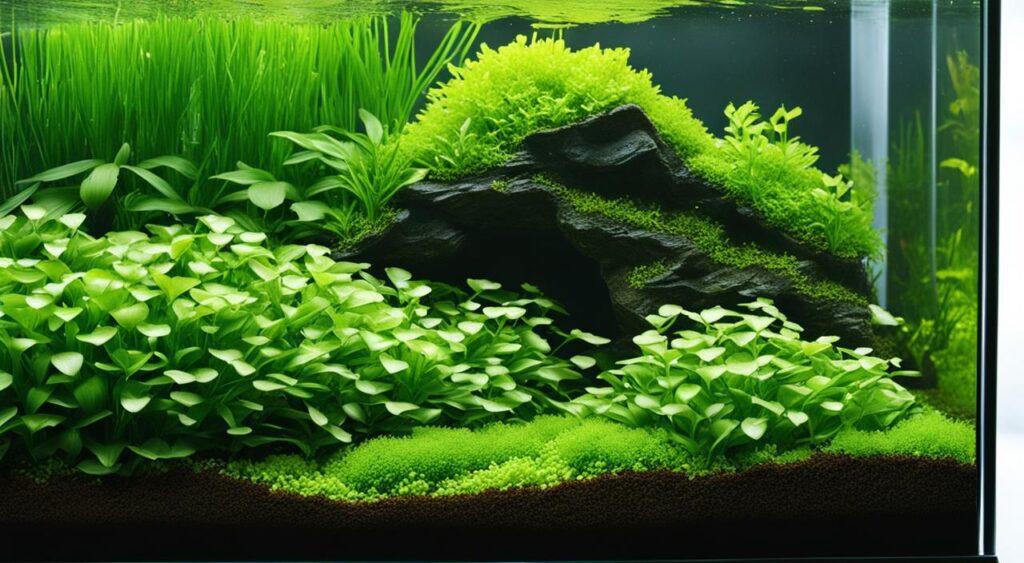
Dwarf Baby Tears requires high light intensity to thrive. It is best suited for aquariums with robust lighting systems, such as LED or metal halide lamps. Insufficient light can cause the plant to become sparse and leggy. In addition to high light, Dwarf Baby Tears also requires CO2 injection to ensure lush and healthy growth. CO2 supplementation using a pressurized CO2 system or liquid carbon sources. Proper placement of the plant is essential to create a carpet effect. It is recommended to plant Dwarf Baby Tears in the foreground of the aquarium, where it can spread and form a dense carpet.
What Are Good Tank Mates?
When choosing tank mates for Dwarf Baby Tears in your freshwater aquascape, it’s crucial to consider compatibility and the impact they may have on this delicate ground cover plant. Here are some options for suitable tank mates and fish species to avoid:
Good Tank Mates
When selecting tank mates for Dwarf Baby Tears, small schooling fish that are peaceful and won’t disturb the delicate carpet of the plant are recommended. Some suitable options include:
- Neon Tetras
- Celestial Pearl Danios
In addition to fish, certain shrimp species can also coexist with Dwarf Baby Tears. Cherry shrimp and Amano shrimp are excellent choices as they are peaceful and won’t disrupt the carpet-like growth of the plant.
Fish Species To Avoid
While many freshwater fish can coexist peacefully with Dwarf Baby Tears, some fish species may pose a threat to the plant. It’s best to avoid aggressive or large fish that may uproot the delicate roots or disturb the carpet formation. Some examples of fish species to avoid include:
- Cichlids
- Goldfish
- Large catfish
By choosing compatible tank mates and avoiding aggressive or disruptive fish species, you can create a harmonious freshwater aquascape that showcases the beauty of Dwarf Baby Tears as a ground cover plant.
Feeding (Fertilization)
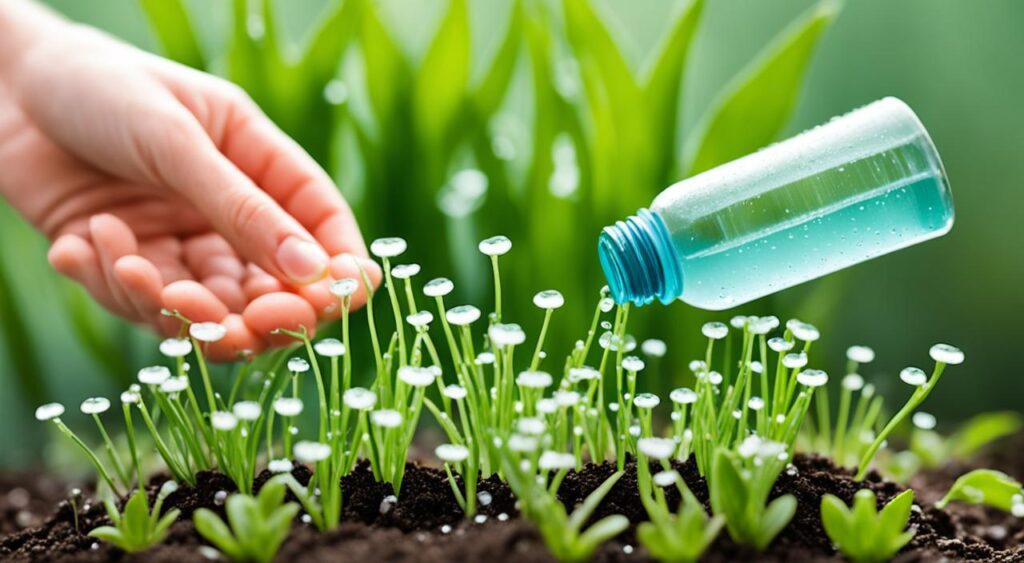
Dwarf Baby Tears requires regular fertilization to ensure healthy growth. This plant has high nutrient requirements and can benefit from adding liquid or substrate fertilizers. The fertilizers should contain essential nutrients such as nitrogen, phosphorus, potassium, and trace elements like iron. It is recommended to follow the dosage instructions provided by the fertilizer manufacturer. Generally, Dwarf Baby Tears should be fertilized once or twice a week to provide the necessary nutrients for lush growth and vibrant colouration.
CO2 Injection
CO2 injection is essential for the successful cultivation of Dwarf Baby Tears. Carbon dioxide is a crucial nutrient for plants and is required for photosynthesis, the process by which plants convert light into energy. There are different methods of CO2 injection available, including the use of pressurized CO2 systems, DIY CO2 setups, or liquid carbon supplements.
Pressurized CO2 systems are the most effective and reliable method, but they can be more expensive. They involve using a cylinder containing compressed CO2 gas, which is released into the aquarium through a diffuser. This method provides precise control over CO2 levels and ensures consistent availability for plant uptake.
DIY CO2 setups offer a more cost-effective alternative. They involve the fermentation of a sugar and yeast mixture, which produces CO2 as a byproduct. The CO2 produced is then introduced into the aquarium through a diffuser. DIY CO2 setups require regular maintenance, as the sugar and yeast mixture needs to be replaced periodically to maintain CO2 production.
Liquid carbon supplements, such as Excel, can also be used as an alternative to gaseous CO2. These supplements contain a source of liquid carbon readily available for plant uptake. They provide a convenient and easy-to-use option for supplementing CO2 levels in the aquarium.
When choosing a CO2 injection method, consideration should be given to the specific requirements and budget of the aquarist. It is vital to provide adequate CO2 levels to ensure lush growth and vibrant colouration of Dwarf Baby Tears.
| CO2 Injection Methods | Advantages | Disadvantages |
|---|---|---|
| Pressurized CO2 Systems | It is more expensive, requires additional equipment and maintenance | May be less effective than gaseous CO2; dosage variations |
| DIY CO2 Setups | Cost-effective, accessible materials, suitable for smaller setups | Requires regular maintenance, CO2 production may fluctuate |
| Liquid Carbon Supplements | Convenient, easy-to-use, readily available carbon source | May be less effective than gaseous CO2, dosage variations |
Care
When caring for Dwarf Baby Tears, certain aspects must be considered to ensure its health and vitality in the aquarium.
Planted Tank Parameters
Creating the ideal environment for Dwarf Baby Tears starts with maintaining specific tank parameters. The recommended temperature range is between 68-82°F (20-28°C), providing the plant with the warmth it needs to thrive. A pH level between 6-7.5 is optimal for healthy growth. Additionally, providing intense lighting with around 3-4 watts per gallon or a high PAR value ensures the plant receives the necessary light for photosynthesis.
Water Quality
Water quality is crucial for the well-being of Dwarf Baby Tears. It is essential to regularly monitor and maintain proper water parameters to prevent stress and ensure the plant’s health. This includes keeping ammonia, nitrite, nitrate, and other contaminants in check. Regular water changes can help maintain the overall water quality and remove any excess nutrients or pollutants that may negatively impact the plant.
Filtration
Adequate filtration is essential for maintaining a clean and healthy aquatic environment for Dwarf Baby Tears. A quality filtration system helps remove debris, excess nutrients, and other impurities from the water, preventing the buildup of harmful substances that can compromise the plant’s health. Use mechanical, biological, and chemical filtration to ensure adequate water purification.
Flow
Maintaining proper water flow in the aquarium is essential for Dwarf Baby Tears. Sufficient water movement ensures proper circulation, preventing stagnant areas that can lead to algae growth or debris accumulation. Consider using a powerhead or a circulation pump to create gentle water flow throughout the tank, avoiding strong currents that may damage the delicate plant.
Recommended Tank Parameters for Dwarf Baby Tears
| Parameter | Ideal Range |
|---|---|
| Temperature | 68-82°F (20-28°C) |
| pH | 6-7.5 |
| Lighting | 3-4 watts per gallon or high PAR value |
| Substrate | Nutrient-rich aqua soil or sand |
| Water Flow | Gentle circulation to prevent stagnant areas |
By creating and maintaining the proper tank parameters, including water quality, filtration, and flow, aquarists can provide optimal conditions for the growth and well-being of Dwarf Baby Tears in their freshwater aquascape.
Aquarium Maintenance
Testing Water Conditions
Regular testing of water conditions is essential for maintaining a healthy aquarium environment for Dwarf Baby Tears. Parameters such as ammonia, nitrite, nitrate, pH, and temperature should be monitored using reliable water testing kits. Any deviations from the ideal range should be addressed promptly to prevent stress or harm to the plant.
How To Set Up Your Aquarium Tank
Setting up the aquarium tank properly is crucial for the success of Dwarf Baby Tears. Here’s a step-by-step guide to help you get started:
- Choose the right size tank for your needs, ensuring enough space for the plant to spread and grow.
- Install a suitable filtration system to keep the water clean and debris-free. This will help maintain optimal water conditions for the plant.
- Add a substrate that is rich in nutrients to promote healthy growth. Nutrient-rich substrates like aqua soil or nutrient-rich sand are ideal for Dwarf Baby Tears.
- Install a high-quality lighting system that provides the necessary intensity for the plant. LED lights or metal halide lamps are preferred options.
- Introduce aquatic plants, including Dwarf Baby Tears, into the tank. Planting them carefully in the desired locations will help create a visually appealing aquascape.
- Monitor and adjust the water parameters as necessary, ensuring that the temperature, pH, and lighting levels remain within the recommended range for Dwarf Baby Tears.
These steps will give you a solid foundation for a successful Dwarf Baby Tears aquascape.
Propagation Methods
Dwarf Baby Tears can be propagated through various methods to expand your aquascape or share it with other aquarium enthusiasts. Here are a few common propagation methods:
- Root Division: Gently separate the plant into smaller sections, ensuring each has a healthy root system. Plant the divided sections in suitable locations within the tank.
- Cuttings: Take stem cuttings from healthy, established plants and trim the leaves to encourage new growth. Plant the cuttings in the substrate, ensuring they are firmly rooted.
- Runners: Dwarf Baby Tears produce runners, which are lateral shoots that spread horizontally. These runners can grow and take root in other tank areas, creating new plants.
By utilizing these propagation methods, you can expand your collection of Dwarf Baby Tears and enhance the overall beauty of your freshwater aquascape.
Health And Disease
Dwarf Baby Tears, like any other plant, require proper care and attention to thrive in a freshwater aquascape. Maintaining their health involves understanding the signs of good and poor health, awareness of common health issues, and taking necessary steps to prevent and treat plant pests.
Signs Of Good Health
A healthy Dwarf Baby Tears plant exhibits vibrant and lush growth. The leaves should be bright green and free from discolouration or damage. The plant should also actively produce new lateral shoots, contributing to the dense carpet effect.
Signs Of Poor Health
On the other hand, signs of poor health in Dwarf Baby Tears include yellowing or browning of leaves, stunted or sparse growth, and the presence of algae or fungal infections. These signs indicate nutrient deficiencies, inadequate lighting, or poor water quality.
Common Health Issues And Treatment
Several common health issues can affect Dwarf Baby Tears. These include nutrient deficiencies, such as a lack of iron or macronutrients like nitrogen and phosphorus, which can be remedied by appropriate fertilization. Inadequate lighting can lead to leggy growth or sparse carpet, which can be addressed by increasing light intensity or duration.
Water quality issues, including high ammonia or nitrate levels, can cause stress and damage to the plant. Regular water testing is crucial to detect and address any water parameter imbalances. Additionally, the improper use of chemical additives or medications in the aquarium can harm Dwarf Baby Tears and other aquatic plants, so caution must be exercised when treating fish diseases or other issues.
Plant Pests
Plant pests like snails, algae, and other unwanted organisms can threaten Dwarf Baby Tears. Snails can damage and consume the plant leaves, while algae growth can compete for nutrients and suffocate the plant. Vigilance and prevention are crucial to managing plant pests, including proper quarantine of new plants, regular maintenance and cleaning, and manual removal of pests when necessary.
Summary
Dwarf Baby Tears, also known as Hemianthus callitrichoides, is a small and delicate aquatic plant highly sought after for its ability to create lush and vibrant carpets in aquariums. With its bright green leaves and compact growth habit, Dwarf Baby Tears can transform any freshwater aquascape into a visually stunning masterpiece.
However, cultivating Dwarf Baby Tears requires specific care and attention. It thrives in high-light environments and benefits from CO2 injection and regular fertilization. Providing optimal conditions, such as the right lighting, nutrient levels, and carbon dioxide supplementation, will ensure the plant’s healthy growth and full potential as a stunning ground cover.
To maintain the beauty of a healthy carpet of Dwarf Baby Tears, it is crucial to monitor water quality regularly and promptly address any deviations from the ideal parameters. Testing water conditions, such as ammonia, nitrite, nitrate, pH, and temperature, will help ensure a suitable environment for the plant’s growth and overall aquatic ecosystem.
In conclusion, by following the recommended care guidelines, aquarists can enjoy the captivating beauty of Dwarf Baby Tears as it thrives as a ground cover plant in their freshwater aquascapes. Its vibrant green carpet provides a visually appealing and natural aesthetic, making it a popular choice for aquascaping enthusiasts who seek to create captivating underwater landscapes.
FAQ
What is Dwarf Baby Tears?
Dwarf Baby Tears, also known as Hemianthus callitrichoides or HC, is a small and delicate aquatic plant that is popular for creating lush and vibrant carpets in aquariums.
How do I care for Dwarf Baby Tears?
Dwarf Baby Tears requires high light intensity, CO2 injection, and regular fertilization. It also thrives in specific tank parameters such as temperature, pH levels, and nutrient-rich substrate. Proper placement, water quality, and filtration are also important for its care.
What are good tank mates for Dwarf Baby Tears?
Some suitable tank mates include small schooling fish like neon tetras or celestial pearl danios, as well as peaceful shrimp species such as cherry shrimp or amano shrimp.
How often should I fertilize Dwarf Baby Tears?
Dwarf Baby Tears should be fertilized once or twice a week with a liquid or substrate fertilizer that contains essential nutrients like nitrogen, phosphorus, potassium, and trace elements.
Do I need to inject CO2 for Dwarf Baby Tears?
Yes, CO2 injection is essential for the successful cultivation of Dwarf Baby Tears. It helps ensure lush and healthy growth, and there are different methods available for CO2 supplementation.
What are the ideal tank parameters for Dwarf Baby Tears?
The recommended temperature range is between 68-82°F (20-28°C), with a pH level between 6-7.5. It requires high light intensity, ideally around 3-4 watts per gallon or a high PAR value, and a nutrient-rich substrate.
How do I test water conditions for Dwarf Baby Tears?
Regular testing of water conditions is essential. Parameters such as ammonia, nitrite, nitrate, pH, and temperature should be monitored using reliable water testing kits.
How can I tell if my Dwarf Baby Tears plant is healthy?
Healthy Dwarf Baby Tears exhibit vibrant and lush growth. The leaves should be bright green and free from discoloration or damage. The plant should be actively producing new lateral shoots, contributing to the dense carpet effect.
What are some common health issues for Dwarf Baby Tears?
Common health issues include algae overgrowth, nutrient deficiency, and plant pests. Proper care, maintenance, and addressing any issues promptly can help prevent these problems.

